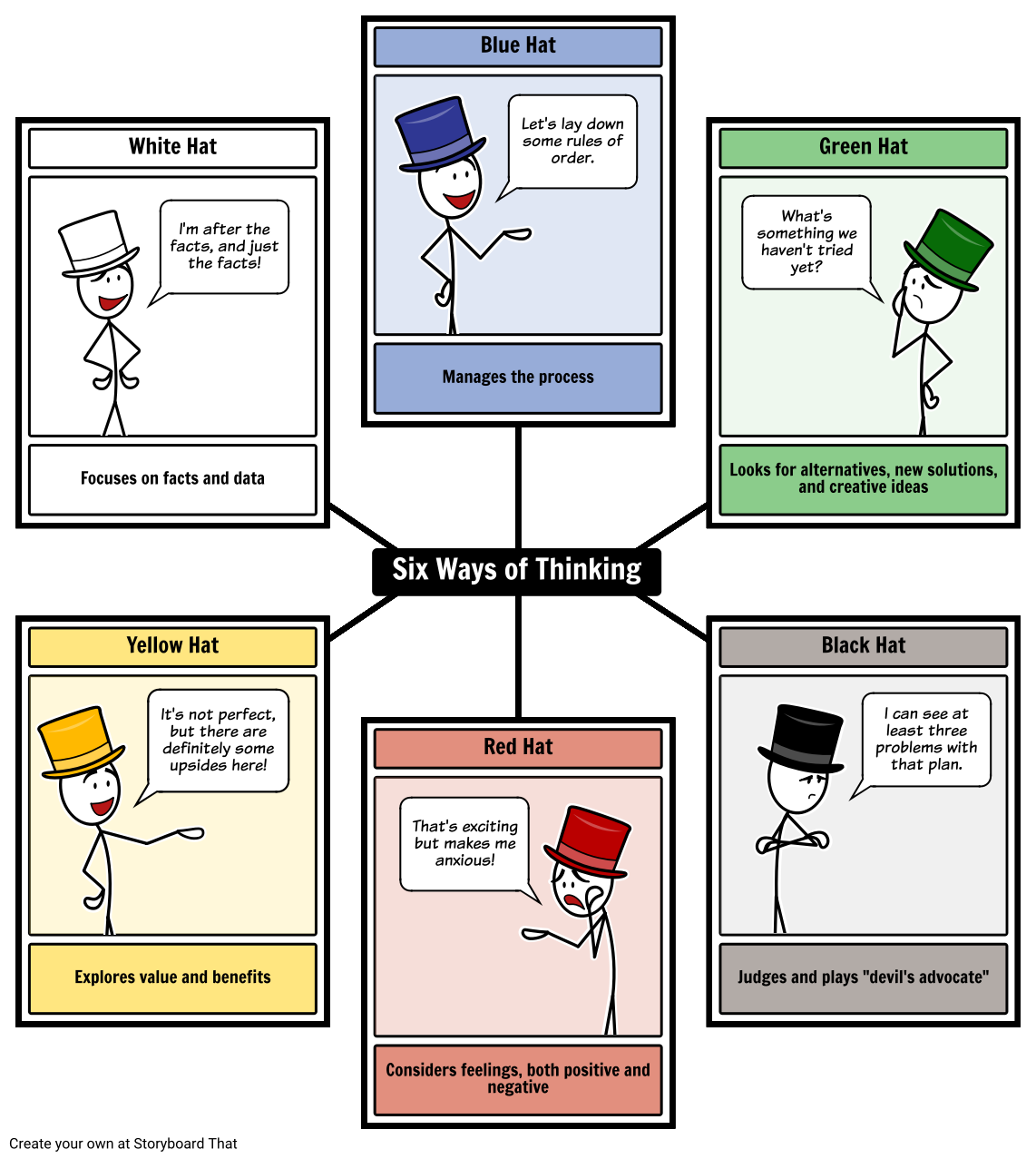Hey! I’m Sara Vaca, independent evaluator and part of the AEA365 team, eventual Saturday contributor. Some time ago, I ran into this framework for critical thinking and I thought it was interesting for evaluators.
Rad Resource: The Six Thinking Hats is a system designed by Edward de Bono which describes a tool for group discussion and individual thinking involving six colored hats. “Six Thinking Hats” and the associated idea parallel thinking provide a means for groups to plan thinking processes in a detailed and cohesive way, and in doing so to think together more effectively.
The premise of the method is that the human brain thinks in a number of distinct ways, which is also the case for evaluators when conducting an evaluation. Six distinct directions in which the brain can be challenged are identified and assigned a color. In each of these directions the brain will identify and bring into conscious thought certain aspects of issues being considered (e.g. gut instinct, pessimistic judgement, neutral facts). None of these directions is a completely natural way of thinking, but rather how some of us already represent the results of our thinking.
The six directions, that in some cases make us think of some paradigms, are:
- Information White – considering purely what information is available, what are the facts? Very relevant to any evaluator, but probably resonating strongly with positivist paradigm.
- Emotions Red – intuitive or instinctive gut reactions or statements of emotional feeling. Clearly something that can emerge more easily with some qualitative methods like life stories.
- Discernment Black – logic applied to identifying reasons to be cautious and conservative. Practical, realistic.
- Optimistic response Yellow – logic applied to identifying benefits, seeking harmony. Sees the brighter, sunny side of situations, which resonate with Appreciative Inquiry approach or method or designs.
- Creativity Green – statements of provocation and investigation, seeing where a thought goes. Thinks creatively, outside the box.
- Managing Blue – what is the subject? what are we thinking about? what is the goal? Can look at the big picture.

Cool Tip: Ask yourself these questions: Which hats you usually wear? And which is the prenominant one? Thinking of this approach could maybe deliberately challenge you to go out of your “natural” tendency, and hence planned for use in a structured way allowing one to develop tactics for thinking about particular issues in your evaluation practice.
Do you have questions, concerns, kudos, or content to extend this aea365 contribution? Please add them in the comments section for this post on the aea365 webpage so that we may enrich our community of practice. Would you like to submit an aea365 Tip? Please send a note of interest to aea365@eval.org. aea365 is sponsored by the American Evaluation Association and provides a Tip-a-Day by and for evaluators.

Hi Sara,
I readily enjoyed reading your post. As an educator I have been focused on finding methods to enhance my students’ creativity, and the Six Thinking Hats system would be a wonderful addition to my current teaching repertoire.
I can also see the usefulness in using this system in evaluation. In my studies, I have come across how evaluators can be subject to looking at a program narrowly or sometimes with an unknowingly biased view. The Six Thinking Hats would certainly help with uncovering biases and allowing an evaluator to see a program from multiple perspectives, delivering a more detailed evaluation.
I imagine using this approach would be better suited for a group of evaluators than just one singular person; even with applying the system, I wonder if cultural and personal experiences might continue to blind the evaluator to their tendencies. Do you have any suggestions of how an individual evaluator might use the Six Thinking Hats approach without biases occurring? Would this need the aid of another evaluator to be most affective?
In your experiences using this approach, were there any setbacks you witnessed and any suggestions which can enhance the overall success of using the system?
As I am currently working in Taiwan, teaching Taiwanese high schoolers and working alongside many Taiwanese staff, I wonder if our differing evaluation approaches and ideologies would yield better results using the Six Thinking Hats or lead to confusion. I can definitely see value in using this approach, but I am rather wary of its overall effectiveness in certain scenarios.
Matthew
Hi Sara,
I enjoyed reading your post. It would be interesting to know how we could promote shifting through the six different thinking hats with our students? What activities might support this? Would it be beneficial to teach students how to apply each hat at a younger age? Would this enhance critical thinking?
As I explore the different hats and the attributes placed within each of them, I find that I tend to use the Red Hat and the Green Hat, but more predominantly, I’d say, they red hat.
It might be interesting to know, or explore, if the thinking hats perhaps also correlate closely to characteristic/personality traits?
Cassandra